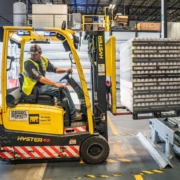Flexible warehouses
Warehouses are increasingly confronted with an increase in Skus and peak moments in demand due to E-commerce developments. In many cases this leads to congestion in the warehouse and deterioration of the delivery performance.
This is not really surprising. Most warehouses are often statically furnished. A fixed picking zone, transfer points and fixed automated jobs that are overloaded at peak times. In addition, both B2B and B2C are often served from the same warehouse. A mix of complete large orders in addition to the many ‘separate’ units that are intended for E-commerce. Below I discuss six strategies that you can follow when setting up your warehouse to absorb the dynamics of E-commerce in your warehouse.
Multiple areas.
Fine picking areas quickly become overloaded at peak times such as commercial promotions. The warehouse manager has to balance between costs and the addition of [temporary] personnel. Even then, the capacity of the picking area is limited due to space limitations. This is not only about picking but also collection and expedition areas.
Flexible warehouses should offer the possibility to set up multiple picking zones to absorb peaks. These should not be static areas, but areas that are set up to meet demand depending on the type of product and the time.
Fast versus slow movers.
The dynamic picking zones are set up partly on the basis of the turnover rate of the product. Split the fast and slow movers by area. Also make sure that your software can handle the dynamic zones. Many warehouse systems require a lot of parameterization if you are going to shift with your areas and locations
Flexible picking techniques.
Many warehouses are tied to a particular method of picking that cannot move with the dynamics of the article flow. These are often fixed in the warehouse where all types of picking items are processed. As a result, the different types of orders can be compromised by overloading the system. One flow blocks the other. Separation of flows and different types of racking, picking modules or even flexible walls help to separate your flows.
So-called A-frames are well suited for small fast-running articles that have similar packaging. Put to Light stations can indicate which items can come together in an outer box for the same customer. Via ‘goods-to-person’ systems, items from different places are delivered from the warehouse to the employee. In addition, carousels offer the opportunity to pick many small items at one point and forward them via specific jobs to one of the multiple shipping zones.
Multiple jobs
Conveyors or ground-handling jobs should give the possibility to choose different routes depending on the type of product or type of flow. In many warehouses, all articles are ultimately led over the same runways, intersections and stations to their final exit destination.
Make sure your conveyors can handle multirouting. This also applies to your software that controls the conveyors. Packages that are ready immediately must go to the expedition via the shortest possible route. [Early out] articles that have multiple actions, such as adding items in the same package, are directed over the conveyors and only pass through those stations where the actions are performed turn into.
Good scanning software.
Many warehouses have fixed automated scanning software. With increasing variety in SKU and the need to merge items, this regularly proves to be an obstacle. Your software and scanning points should be flexibly arranged so that both automatic and additional manual scanning is possible to enable good combination of articles.
Cost savings on packaging.
For a long time, warehouses focused on standard packaging and repackaging in order to purchase cost-efficiently on packaging. However, more and more carriers are not only focusing on weight in terms of price, but also on cubic meters of space. Combining items in the smallest possible packaging is not only customer-friendly, but ultimately also more cost-effective. From an environmental point of view, too, the correct outer carton is better than standard packaging, which often has to be filled extra with filling material to ‘secure’ the items in the outer carton.
Summarizing.
More and more warehouses are confronted with increasing pressure on the [correct] stock, an increase in SKU and continuous peak moments with widely varying demand from different market channels. This dynamic from the market must be reflected in the design and management of the warehouse. Flexible equipment, software that can be parameterized faster, multi-routing solutions and a dynamic layout of your warehouse. At the current market ka








